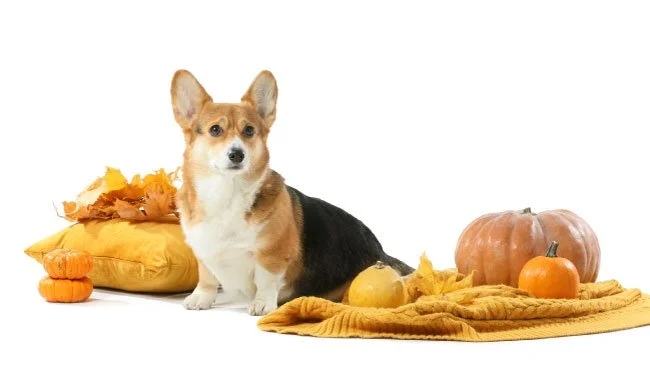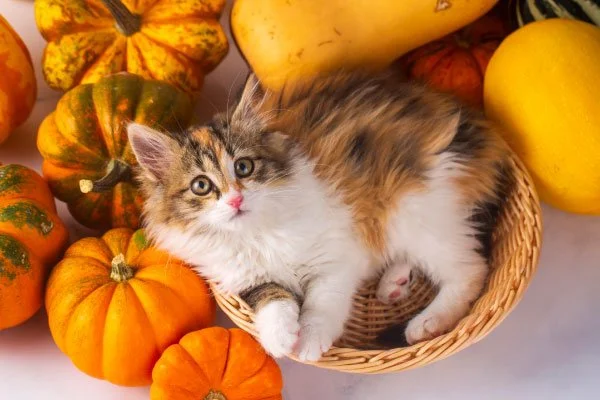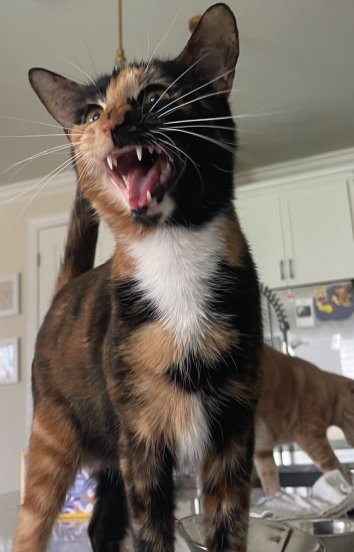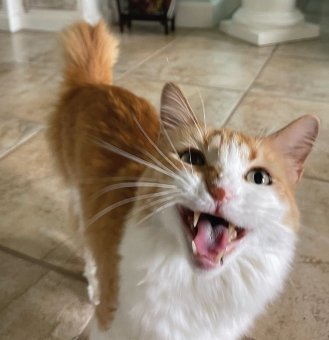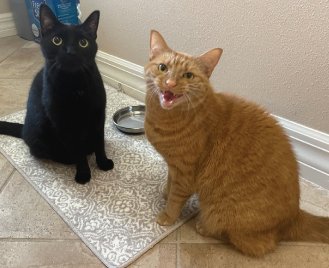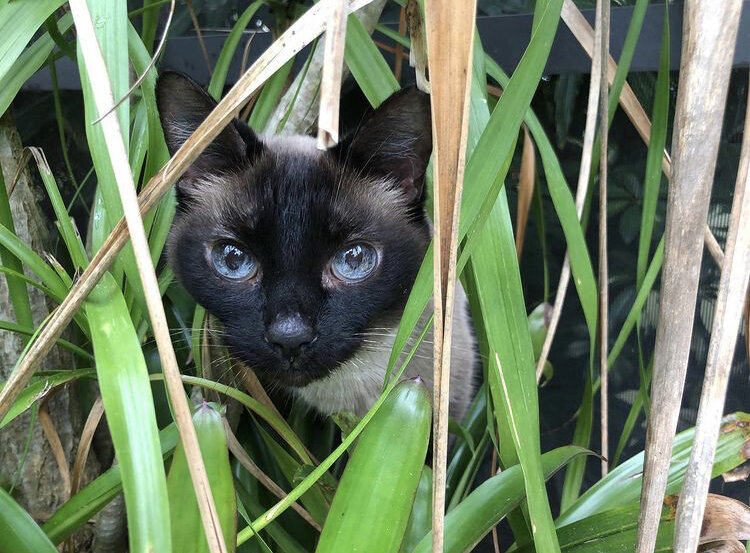Pumpkin: A Pet’s Fall Favorite
While you're sipping your latte or baking pies, don’t forget your furry friend can enjoy pumpkin too! Both cats and dogs can safely enjoy this festive favorite, and it’s more than just a tasty treat!
Whether your pet is dealing with a bit of constipation or the opposite problem, pumpkin can be a gentle, natural way to help. Thanks to its high fiber content, just a spoonful of plain canned pumpkin can help regulate digestion and keep your cat or dog’s tummy feeling good. It’s a simple, tasty fix for those occasional digestive hiccups and most pets love the flavor too!
Pumpkin is low in calories, but high in fiber, which means it helps your dog or cat feel full without the extra calories. It’s a great way to add a little bulk to their meals and keep them satisfied longer if you’re trying to get your pet to shed a few extra pounds.
Packed with vitamin A, zinc, and healthy fatty acids, pumpkin can help improve your pet’s skin and coat. Whether your dog’s dealing with dry skin or your cat needs a little extra shine, adding a bit of pumpkin to their meals can help them look and feel their best. It’s like a spa day, but in a bowl.
Pumpkin has a high water content, which can help keep your pet hydrated—especially if they’re not big water drinkers. Adding a spoonful to their food is an easy way to support hydration while also giving them a tasty, nutrient-rich treat.
Who knew something as humble as pumpkin could be such a powerhouse for your pet? Whether it’s helping with digestion, adding a little shine to their coat, or just being a tasty treat, pumpkin’s got a lot going for it.
Just remember—plain, unsweetened pumpkin only, and always check with your vet before making it a regular thing. A spoonful here and there could make a big difference (and earn you some serious tail wags or purrs).
Reference:
How To Check Your Pets for Ticks and Fleas
Keeping your pet healthy and comfortable means being proactive about potential pests like ticks and fleas, especially if they are outdoors often.
Pet-related fleas and ticks are common parasites that live on animals like dogs and cats, feeding on their blood. Fleas can cause itching, skin irritation, and allergic reactions, while ticks are known for transmitting diseases. These tiny parasites can cause big problems if left unnoticed, so knowing how to check your pet regularly is essential.
Supplies:
Tick Remover (left) and Flea Comb (right)
Flea Comb
Tick Remover/Tweezers
Magnifying glass (optional)
Gloves (optional)
Container/Bags (to place tick after removal)
Check Skin:
Ticks often attach themselves firmly to the skin.
Gently feel through your pet’s coat with your fingers, then run a flea comb through your pet’s fur, especially in thick or long areas. Fleas can get trapped in the comb’s teeth, allowing you to remove them. This will not only help you spot them but will also give you a chance to see any signs of irritation.
Fleas: Look for small, deep brown or black specks moving in the fur. You might also see "flea dirt," which are tiny black specks that look like ground pepper.
Ticks: Ticks are larger, often gray, or brown, and can be the size of a sesame seed or larger when engorged with blood. They might be found attached to your pet’s skin, typically around the ears, around their eyes, underarms, bellies, or between the toes.
NexGard is a once monthly chewable supplement that prevents and protects dogs from ticks, fleas and parasites.
Removing Fleas and Ticks:
For Fleas: If you find fleas, use a flea shampoo, or consult your vet about the best flea treatments. You can also use flea medication or collars as a preventive measure.
For Ticks: Use a pair of tweezers or a tick-removal tool to grab the tick close to your pet’s skin and pull it out gently, placing it into a sealed bag/container so that it does not escape. Avoid twisting the tick to prevent leaving parts of the tick behind. Dispose of the tick properly and monitor the bite site for any signs of infection.
After handling ticks, fleas, or anything your pet may have been exposed to, always wash your hands thoroughly with soap and water.
References:
https://www.petmd.com/dog/how-check-dog-ticks
https://www.banfield.com/Wellness-at-banfield/Skin-and-coat-care/How-to-check-for-fleas
A Guide To Verbal Cat Communication
Welcome to the purr-fect world of feline linguistics! Cat boast an impressive vocabulary of up to 21 distinct vocalizations, each a note in the symphony of cat communication. It's not just meows and purrs; it's a real language that can be as complex as a human conversation.
Welcome to the purr-fect world of feline linguistics! Cats boast an impressive vocabulary of up to 21 distinct vocalizations, each a note in the symphony of cat communication. It's not just meows and purrs; it's a real language that can be as complex as a human conversation.
Not all cats are born chatterboxes. Some, like the Maine Coons, tend to be part of the quieter breeds, while others, like the Siamese, are the talkative kitties of the feline universe.
Meowing: The signature soundtrack of feline communication! Kittens use it to summon their moms, but in adulthood, it becomes the cat's go-to language for humans. From greetings to playtime requests, expressions of excitement or frustration, to demanding attention, food, or room access – meows are the most popular of the cat communication world.
Purring: In the world of feline communication, there's one sound that reigns supreme – the purr! This sound is typically an indicator that your kitty is in a state of bliss—think lounging in a warm sunbeam or receiving chin scratches while sitting on their human’s lap. Interestingly, cats purr at a frequency between 25-150 Hertz, known to have therapeutic effects on bones and tissues. Beyond contentment, they may purr to self-heal, reduce stress, and even communicate with humans. The unique purring sound originates from the cat's laryngeal muscles rapidly contracting and relaxing.
Trilling: A trill is a high-pitched musical sound made by some cats during specific situations. Cats reserve this delightful sound for greetings and thanking their human admirers, often for treats or affection. They may also use this when communicating to their favorite feline sibling. It's the cat's way of saying, "You're my favorite."
Chirping: Initially, chirping is a mother cat's call to her kittens, adult cats also use chirps to grab attention and share their whereabouts. When faced with tantalizing prey outside the window, a chirp signifies excitement, tinged with a dash of frustration.
Chattering: Have you ever caught your cat silently chattering away? It's not Morse code; it's their voiceless jaw clash, usually reserved for spotting prey out of reach. It's the rhythm of their imaginary hunt.
Growling and Hissing: Growling is a low rumble signaling threats and impending feline fury. Hissing, its dramatic cousin, is the involuntary response to a surprise threat. Both come with a side of fear-inducing body language – arched back, flattened ears, twitching tail, and the classic Halloween cat posture. When the growls and hisses start, heed the cat's message: "Step back, I'm not in the mood!"
Spitting: More intense than a hiss, this explosive burst signals a peak threat situation. It's the cat's way of saying, "Seriously, back off!" – accompanied by a swift, lashing-out movement for added drama.
Yowling and Howling: Imagine a cat's meow on steroids, and you've got yowling – a prolonged, distressed sound. Howling is its shorter cousin. These are the sirens of cat communication, indicating physical or emotional distress. Separation anxiety, pain, or just a need for attention – it's their way of belting out their feelings.
Caterwauling: A loud, long whine reserved for unspayed females in heat. Directed at human family members, it's their expression of pain, discomfort, fear, or a blatant demand for attention.
In this enchanting world of feline sounds, any change in frequency, intensity, duration, or pitch is your cat's SOS. A trip to the vet might be in order, and for some, a dash of anxiety or pain meds could be the magical remedy. So, listen closely, fellow cat enthusiasts, for in their symphony of sounds, your furball's story unfolds, one delightful meow at a time!
References
11 Holiday Safety Tips For Your Pet
As the holiday season approaches, our homes transform into bustling hubs of celebration. Among the twinkling lights and festive feasts, it's essential to remember the well-being of our beloved pets. While they eagerly partake in the holiday excitement, their safety must remain a priority.
Mind the Decorations: Holiday decorations can be fascinating to our pets but can also be dangerous. Keep a close eye on tinsel, ribbon, and small ornaments that could be choking hazards. Opt for pet-friendly decorations and secure larger ones out of your pet's reach.
Create a Calm Retreat: Holiday gatherings can be overwhelming for pets with all the noise and commotion. Designate a quiet, safe space where your furry friend can retreat when they need a break. Provide comfortable bedding, water, and their favorite comfort items to make it an inviting, relaxing place.
Watch the Door: Holiday gatherings mean more people coming and going from your home. Keep an eye on your pets near the door, as they may try to slip outside, especially if they're anxious or curious about the guests.
Secure the Trash: The aroma of holiday leftovers can be irresistible to pets. Ensure trash cans are securely closed or kept in a pet-proof area to prevent scavenging, which can lead to digestive issues.
Pet-Proof Your Feast: Be cautious about what your pets consume while indulging in holiday feasts. Many human foods, such as chocolate, grapes, onions, and alcohol, can be toxic to pets. A trigger for pancreatitis in our furry friends often stems from the consumption of high-fat foods. During holiday seasons, this can include indulgences such as turkey (especially the skin), fatty leftovers, gravy, bacon, and dishes with butter. Keep festive foods out of their reach and discourage guests from feeding them table scraps. Never give your pet cooked bones. Bones can splinter into shards that injure your pet's mouth and digestive tract. They can also harden in their intestines, causing a blockage.
Be Cautious with Candles: If you're using candles for ambiance, place them out of your pet's reach. Curious pets can knock them over and cause fires or burns. Consider using flameless, battery-operated candles as a safer alternative.
Limit Access to Electrical Cords: Holiday lights and decorations often come with electrical cords that can attract pets. Use cord covers or secure them in a way that keeps your pets from chewing on them, which can lead to electrical shock.
Avoid Harmful Plants: Certain holiday plants, like poinsettias, mistletoe, and holly, can be toxic to pets if ingested. Keep them away, or consider using artificial alternatives to keep your pets safe and your home festive. Curious about which other plants are harmful to your pets? Click here to find out!
Introduce Your Pet to New Faces: If you're hosting guests, especially those with children or other pets, ensure proper introductions with your own pets. Some pets may be anxious around unfamiliar faces, so a gradual introduction can help ease tension. Remind guests, especially children, how to properly interact with your pet to avoid potential anxiety in your pet that may result in a reactive bite or scratch. If your pet isn't fond of company, escort them to their safe space and check on them during the event.
On The Road Again: If the holiday takes you on a road trip, make sure your pet is wearing proper identification, a harness that is secured to a tether or doggy seat belt (do not attach any restraint directly to their collar), or place them in their crate (secured to the vehicle in the event of an accident). Bring food/treats, bowls, water, leash, potty supplies, blanket, medication, first-aid kit, toys, and vet documents. Create a list of emergency vets along your route in case of emergency or illness.
Exercise Your Pal: Be mindful of your pet's need for proper exercise during the busy season. Create a schedule that allows time to care for your pet, or call your local pet-sitting company for assistance!
Resources
VETSS
Toxic Plants and Flowers To Avoid For Dogs And Cats
As a pet parent, it’s very important to be knowledgeable about which plants and flowers could be dangerous to your puppy pals and feline friends. Below is a list of the most common toxic plants that are dangerous for pets to consume.
Please note, this is not a complete list of all poisonous plants.
As a pet parent, it’s very important to be knowledgeable about which plants and flowers could be dangerous to your puppy pals and feline friends. Below is a list of the most common toxic plants that are dangerous for pets to consume.
Please note, this is not a complete list of all poisonous plants.
Adam-and-Eve
Aloe
Amaryllis
Andromeda
Apple
Apricot
Arrow-Head Vine
Arum
Arum Lily
Australian Nut
Autumn Crocus
Azalea
Barbados
Basil
Bay Laurel
Bead Tree
Begonia
Bird of Paradise
Bittersweets
Brazilwood
Boxwood
Brunfelsia
Buckeye
Buckwheat
Buddhist Pine
Burning Bush
Buttercup
Calla Lily
Caladium
Cape Jasmine
Cardinal Flower
Carnation
Castor Bean
Ceriman
Chamomile
Cherry
Chinaberry
Chives
Chrysanthemum
Cilantro
Clematis
Coffee
Coontie Palm
Creeping Charlie
Cycads
Cyclamen
Daffodil
Daisy
Dieffenbachia
Dracaena
Dumbcane
Easter Rose
Eastern Star
Elephant Ears
Epazote
Eucalyptus
Exotica
Fern Palm
Fig
Figwort
Flag
Flamingo Flower
Foxglove
Gardenia
Garlic
Geranium
Gladiola
Grapefruit
Heavenly Bamboo
Holly
Hops
Horse Chestnut
Horseweed
Hosta
Hyacinth
Hydrangea
Indian Hemp
Iris
Ivy
Jack-in-the-Pulpit
Jonquil
Kalanchoe
Kiss-me-Quick
Klamath Weed
Lambkill
Lantana
Larkspur
Laurels
Lavender
Leek
Lemon
Lemon Grass
Lenten Rose
Lillies
Lime
Lobelia
Maidens Breath
Marijuana
Milkweed
Mint
Mistletoe
Morning Glory
Mother-in-Law
Mum
Nandina
Narcissus
Nightshade
Oleander
Onion
Orange
Oregano
Parsley
Peach
Peony
Perennial Pea
Periwinkle
Pieris
Plum
Poinsettia
Poison Daisy
Poison Hemlock
Poison Parsnip
Portulaca
Prayer Bean
Primrose
Privet
Purslane
Ragwort
Ranger's Button
Red Emerald
Red Maple
Rhododendron
Rhubarb
Ribbon Plant
Rock Moss
Rosebay
Running Myrtle
Sabi Star
Sago Palm
Silver Dollar
Snake Lily
Sorrel
SowBread
Spanish Thyme
Spindle Tree
Spring Parsley
Staggerbush
Starch Root
Starleaf
Sweet Pea
Taro
Tobacco
Tomato
Tulip
Weeping Fig
White Heads
Wild Arum
Winterberry
Wisteria
Yarrow
Yew
Yucca
ASPCA Animal Poison Control Center Phone Number: 888-426-4435
Top Items To Have In Your Pet First Aid Kit
Having a complete pet first aid kit is an important step to ensure the safety and well-being of your pet in case of a serious emergency or a simple cut or scrape. Be certain that your kit accompanies you and your pet on trips to the dog park, campgrounds, and family road trips so you always have the items readily available no matter where you may be. Always inform your pet sitters and family members where the kit(s) are stored. All items can be picked up in one trip to the drug store or ordered online as a complete kit.
Having a complete pet first aid kit is an important step to ensure the safety and well-being of your pet in case of a serious emergency or a simple cut or scrape. Be certain that your kit accompanies you and your pet on trips to the dog park, campgrounds, and family road trips so you always have the items readily available no matter where you may be. Always inform your pet sitters and family members where the kit is stored so they can be prepared to care for your pet should an emergency arise.
All of the following items can be picked up in one trip to the drug store or ordered online as a complete kit:
Important Phone Numbers
Add the following numbers to your phone’s contacts and write them on an index card that can be stored in your kit:
ASPCA Poison Control Center: 888-426-4435
Your Veterinarian include address and phone number
Local 24/7 Emergency Pet Hospitals
Pet Identification & Vaccination Record
Quick access to these important records are essential should your pet need to be seen by emergency pet hospital personnel or should you need to refer to them when calling poison control.
Pet First Aid Guide
A quick reference guide with specific directions on how to properly use the items in your kit.
Medications
Consult your vet about proper doses of medications for your pet and write them on each box.
Aspirin Tablets
Benadryl
Anti-diarrheal (Loperamide)
Anti-Nausea/Motion Sickness (may need to get from vet)
Burn Gel (with Lidocaine)
Neosporin
Antiseptic Wipes
Betadine Antiseptic Solution
Sting Relief Pads (Benzocaine)
Hydrogen Peroxide (helps induce vomiting if pet ingested something poisonous)
Eye Wash
Eye wash can help alleviate irritation and flush away dirt and debris.
Ear Wash
Ear wash flushes debris trapped within the canal that may lead to infection if not removed.
Tweezers
Tweezers are handy for removing splinters, burrs, ticks, and other hard to grasp irritants that may attach to your pet’s skin.
Tongue Depressor
These are a great tool to use when examining your pet’s mouth.
Digital Thermometer & Lubricant
The most reliable way to obtain your pet’s temperature is rectally, which is why lubricant is important for the comfort of your pet. Note that dogs and cats have a temperature range that is higher than humans. Normal body temperature for dogs is 101-102.5 and for cats 100.4-102.5 degrees Fahrenheit.
Instant Cold Packs
Certain injuries require cold compresses to help reduce inflammation and relieve pain, such as bee stings, sprains, and strains. Always place a buffer, such as a towel, between the cold pack and your pet’s skin to avoid cold-induced skin damage.
Sterile Rolled Gauze and NON-STICK Pads (2 x 2, 4 x 4)
Gauze and pads are useful when cleaning out a wound and are also the first layer when covering and bandaging wounds. Only use a non-stick pad next to the wound before loosely wrapping with a gauze bandage.
Adhesive and Elastic Tape
Tape assists in holding the bandage in place.
Self-adhering Bandage Wrap
This is used as the outer layer when creating a bandage to help keep the sterile bandage in place.
Q-Tip Swabs (sterile if possible)
Another great tool when cleaning out wounds.
Splints
Splints are important to immobilize a pet's injured limb during transport to the vet or emergency facility. Homemade splints can be made out of pieces of cardboard or rolled up newspapers and magazines. A pencil, small ruler, or tongue depressor are all possible choices for smaller dogs and cats.
Stainless Steel Scissors
Scissors come in handy when cutting off bandages and creating splints.
Exam Gloves
Wearing gloves will help minimize the risk of infection to the wound site.
Children’s Socks
A pair of size-appropriate, children's socks are the perfect solution to cover a wounded paw.
BlanketS
A mylar emergency blanket or soft, thick blanket are useful for keeping your pet warm if they've sustained an injury outside in the cold and/or rain.
Syringes
Syringes assist in administering medications into your pet’s mouth or flushing a wound. At some point, you may have received these from your vet to administer meds.. be sure to keep them for your kit!
Odor Remover (De-Skunking)
1 qt 3% hydrogen peroxide, 1/4 C baking soda, 1 tsp dish soap, access to plenty of running water (hose) for rinsing. Leave solution on for 5-minutes and then shampoo. Note: Do not make this solution ahead of time, it must be prepared and then used immediately!
A Sturdy Container
A duffle bag, plastic bin, or tackle box are options to contain your first aid items.
